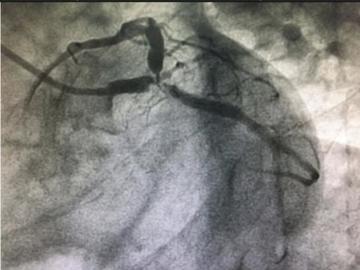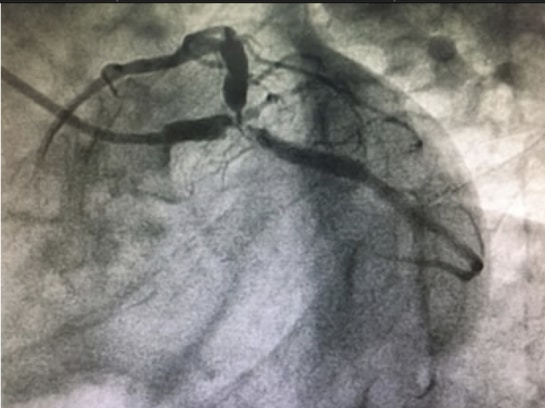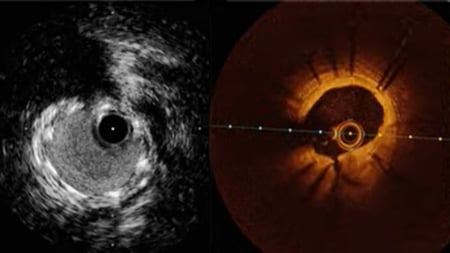26 Mar 2020
Impact of kissing balloon in patients treated with ultrathin stents for left main lesions and bifurcations: an analysis from the RAIN-CARDIOGROUP VII study
Selected in Circulation Cardiovascular Interventions by A. N. Calik , P. Xaplanteris
The objective of this analysis was to investigate the potential benefits of FKI in bifurcations treated with new generation ultrathin stents using a 1- or 2-stent technique.
References
Authors
Gaido L, D'Ascenzo F, Imori Y, Wojakowski W, Saglietto A, Figini F, Mattesini A, Trabattoni D, Rognoni A, Tomassini F, Bernardi A, Ryan N, Muscoli S, Helft G, De Filippo O, Parma R, De Luca L, Ugo F, Cerrato E, Montefusco A, Pennacchi M, Wańha W, Smolka G, de Lio G, Bruno F, Huczek Z, Boccuzzi G, Cortese B, Capodanno D, Omedè P, Mancone M, Nuñez-Gil I, Romeo F, Varbella F, Rinaldi M, Escaned J, Conrotto F, Burzotta F, Chieffo A, Perl L, D'Amico M, di Mario C, Sheiban I, Gagnor A, Giammaria M, De Ferrari GM
Reference
Circulation: Cardiovascular Interventions. 2020;13:e008325
Published
March 2020
Link
Read the abstractReviewers
Our Comment
Why this study – the rationale/objective?
The ultrathin struts of new drug-eluting stents (DES) are associated with a lower risk of stent thrombosis (ST) and a lower rate of repeat revascularisation. However, there is a paucity of data regarding their safety and efficacy in left main lesions or coronary bifurcations. Furthermore, the potential benefits of final kissing balloon inflation (FKI) in bifurcation lesions is still debated, particularly following single stent strategies.
The RAIN study, a multicenter retrospective observational registry, included all consecutive patients undergoing complex percutaneous coronary interventions involving left main (LM) and/or bifurcation with ultrathin stents.
The objective of the current analysis was to investigate the potential benefits of FKI in bifurcations treated with new generation ultrathin stents using a 1- or 2-stent technique.
How was it executed – the methodology?
The study population was divided into two groups according to having FKI or not and propensity score adjustment was applied.
The primary endpoint was major adverse cardiac events (MACE; a composite endpoint of all-cause death, myocardial infarction, target lesion revascularisation [TLR], and stent thrombosis [ST]), whereas target vessel revascularisation (TVR) and the components of MACE were the secondary endpoints.
Subgroup analyses were performed for short (overlap <3 mm between the 2 balloons) versus long FKI and one (provisional) versus 2-stent strategy.
What is the main result?
2742 patients were included in the study: 1619 were treated with no-FKI and 1123 with FKI.
At a median follow-up of 16 (8–20) months, after adjustment with Inverse Probability of Treatment Weighting (IPTW), no significant differences were found in terms of MACE (15.1% versus 15.2%; P =0.967), or secondary endpoints, including death (6.4 % vs. 6.2 %; P= 0.797), myocardial infarction (5.3% vs. 7.0%; P =0.408), TVR (6.3% vs. 6.3%; P =0.996), TLR (5.4% vs. 5.6%; P =0.932), and ST (2.5% vs. 3.6%; P =0.545).
In the subgroup analysis according to bifurcation strategy, there were no statistically significant differences in MACE rates (12.4% vs. 15%; P =0.311) and secondary endpoints between FKI and no-FKI in the provisional group. However, in the 2-stent strategy group, FKI reduced the incidence of MACE (16.6% vs. 24.9%; P =0.083), TVR (7.8% vs. 15.9%; P =0.030), and TLR (7.3% vs 15.2%; P =0.032), independent of the overlap length.
As regards the role of overlapping kissing balloons, a short overlap (<3 mm) was associated with lower rates of TVR (3.2% vs. 6.3%; P =0.037) and TLR (2.6% vs. 5.4%; P =0.034) compared with no-FKI.
Critical reading and the relevance for clinical practice
This is the first real-world, observational registry in patients treated with ultrathin stents for LM and bifurcation lesions that evaluated the impact of FKI (in both provisional and 2-stent strategies) on long-term follow-up.
Overall, the adjusted MACE rates were similar between the FKI and no-FKI groups, independently of the use of imaging, proximal optimisation technique (POT) or routine versus bail-out FKI.
The present study, in line with previous reports, demonstrated that patients treated with a 2-stent strategy experienced less restenosis with FKI. In the overall study population, the efficacy of FKI was found to be restricted to cases in which it was performed with a short overlap (<3 mm).
The results of this registry should be interpreted by keeping in mind its retrospective, non-randomised nature and the fact that propensity score matching can still leave residual confounding between groups.

Left main distal bifurcation lesion








1 comment
thanks